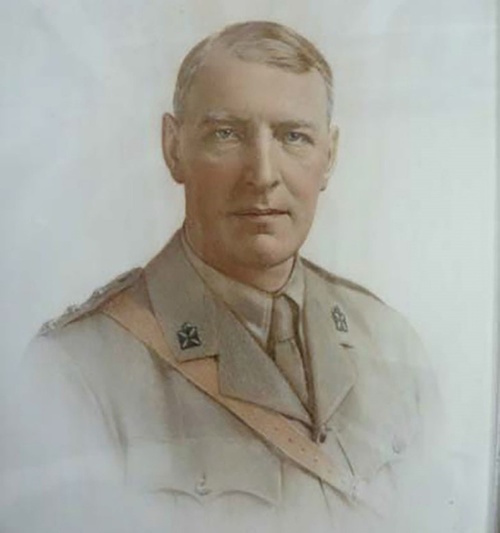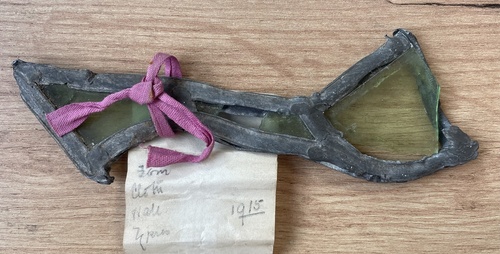Auction: 24113 - Orders, Decorations and Medals - e-Auction
Lot: 834
An interesting collection of Great War ephemera formerly the property of The Rev. Rupert Inglis, Army Chaplains Department, including a small section of stained-glass window taken from the ruins of Ypres's famous Cloth Hall
The damaged segment of lead-lined stained-glass with additional piece of old blue glass, and attached pencil written note, 'From Cloth Hall, Ypres, 1915'; and related the trench art including a brass matchbox holder made from shell casing and inscribed 'Souvenir Ypres'; an assortment of expended bullets and jagged pieces of shrapnel, the former including two with upper segments fashioned into crosses, and another for use as a pendant; and a booklet of 20 wartime post cards depicting damaged buildings in Arras, the whole contained in a scarce Great War presentation chocolate tin, 'The Gift of the Colonies of Trinidad, Grenada and St. Lucia to His Majesty's Naval and Military Forces', as manufactured by Barringer Wallis & Manners Ltd. of Mansfield, condition commensurate with age (Lot)
Provenance:
A gift to the current vendor from the daughter of The Rev. Rupert Inglis.
Rupert Edward Inglis was born in London on 17 May 1863 and was educated at Rugby School, where he played cricket with Marylebone Cricket Club. But it was at rugby that he particularly excelled, not least at Oxford, where he played for the university team in 1883-84. After graduating in History, he went on to become a Deacon at Ely Theological College, where he was ordained in 1889.
During his theological studies, he played for Blackheath (London), one of the most prestigious clubs in England at the time and he began his international career in 1886, playing for England against Ireland, Scotland, and Wales; he was selected a total of 3 times as third row wing in the England team. He stopped his rugby career after moving to Frittenden in the south of England and becoming a priest. He married Helen Mary Gilchrist on 11 June 1900, and they had two daughters and a son.
When the Great War broke out, and despite his advanced age, he enlisted in the Army. In a letter to his parishioners in July 1915, he explained his reasons:
'I have felt that in this great crisis in our nation's history, everyone ought to do what he can to help. I have said this both publicly and privately, but it has been hard to tell people that they ought to leave their homes, to go out into strange new surroundings, to endure discomforts and danger - perhaps to face death - it was hard to tell people that this was their duty and then to remain comfortably at home myself.'
Sent to France as a military chaplain for the Protestant church, his main task was to attend to the spiritual needs of the soldiers, read the last rites and help evacuate the wounded. For a short while he served at No. 23 General Hospital, Etaples, and then joined No. 21 Casualty Clearing Station at Corbie. In December 1915, he was attached to the 16th Infantry Brigade, 6th Division, in the Ypres Salient.
During the fighting near Ginchy on the Somme on 18 September 1916, he joined a party of stretcher-bearers in order to help bring in the wounded. While doing this, he was struck by a fragment of shell and was in the process of having the wound dressed when he was hit by a second shell and killed instantaneously, aged 53.
He has no known grave and is commemorated on the Thiepval Memorial and at Twickenham Stadium, the legendary home of the English rugby team.
Subject to 20% VAT on Buyer’s Premium. For more information please view Terms and Conditions for Buyers.
Sold for
£210
Starting price
£40







